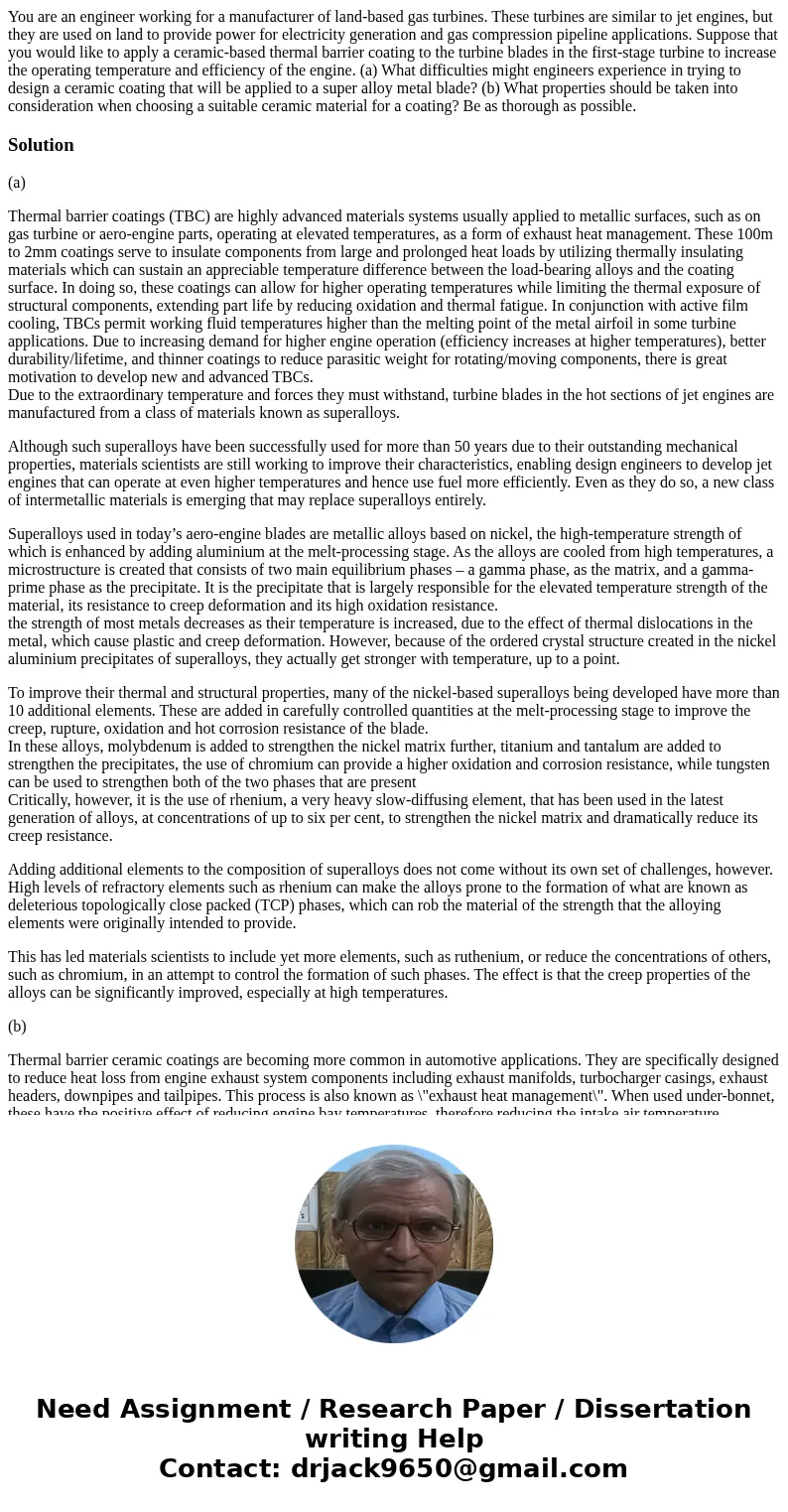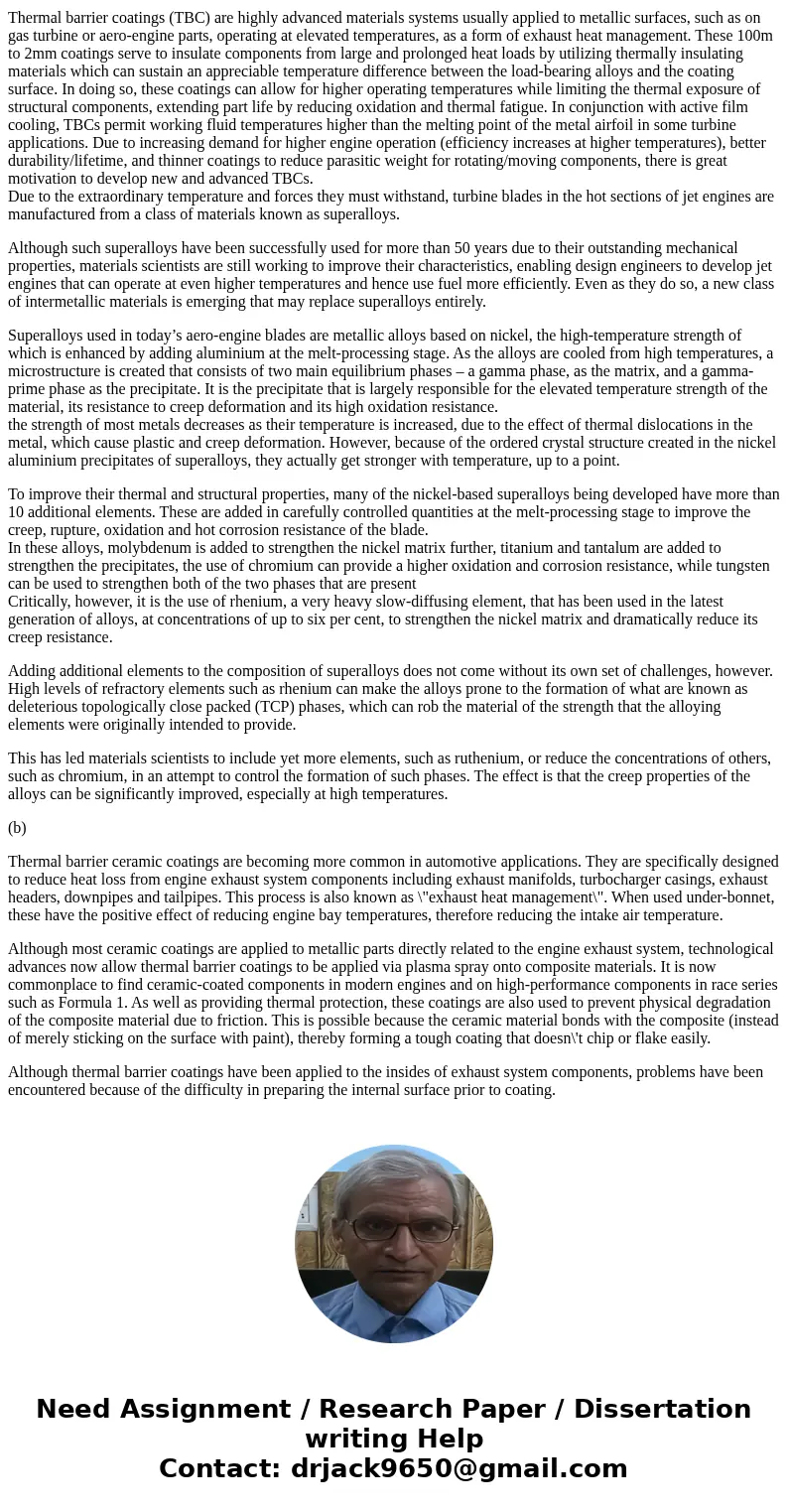You are an engineer working for a manufacturer of landbased
Solution
(a)
Thermal barrier coatings (TBC) are highly advanced materials systems usually applied to metallic surfaces, such as on gas turbine or aero-engine parts, operating at elevated temperatures, as a form of exhaust heat management. These 100m to 2mm coatings serve to insulate components from large and prolonged heat loads by utilizing thermally insulating materials which can sustain an appreciable temperature difference between the load-bearing alloys and the coating surface. In doing so, these coatings can allow for higher operating temperatures while limiting the thermal exposure of structural components, extending part life by reducing oxidation and thermal fatigue. In conjunction with active film cooling, TBCs permit working fluid temperatures higher than the melting point of the metal airfoil in some turbine applications. Due to increasing demand for higher engine operation (efficiency increases at higher temperatures), better durability/lifetime, and thinner coatings to reduce parasitic weight for rotating/moving components, there is great motivation to develop new and advanced TBCs.
Due to the extraordinary temperature and forces they must withstand, turbine blades in the hot sections of jet engines are manufactured from a class of materials known as superalloys.
Although such superalloys have been successfully used for more than 50 years due to their outstanding mechanical properties, materials scientists are still working to improve their characteristics, enabling design engineers to develop jet engines that can operate at even higher temperatures and hence use fuel more efficiently. Even as they do so, a new class of intermetallic materials is emerging that may replace superalloys entirely.
Superalloys used in today’s aero-engine blades are metallic alloys based on nickel, the high-temperature strength of which is enhanced by adding aluminium at the melt-processing stage. As the alloys are cooled from high temperatures, a microstructure is created that consists of two main equilibrium phases – a gamma phase, as the matrix, and a gamma-prime phase as the precipitate. It is the precipitate that is largely responsible for the elevated temperature strength of the material, its resistance to creep deformation and its high oxidation resistance.
the strength of most metals decreases as their temperature is increased, due to the effect of thermal dislocations in the metal, which cause plastic and creep deformation. However, because of the ordered crystal structure created in the nickel aluminium precipitates of superalloys, they actually get stronger with temperature, up to a point.
To improve their thermal and structural properties, many of the nickel-based superalloys being developed have more than 10 additional elements. These are added in carefully controlled quantities at the melt-processing stage to improve the creep, rupture, oxidation and hot corrosion resistance of the blade.
In these alloys, molybdenum is added to strengthen the nickel matrix further, titanium and tantalum are added to strengthen the precipitates, the use of chromium can provide a higher oxidation and corrosion resistance, while tungsten can be used to strengthen both of the two phases that are present
Critically, however, it is the use of rhenium, a very heavy slow-diffusing element, that has been used in the latest generation of alloys, at concentrations of up to six per cent, to strengthen the nickel matrix and dramatically reduce its creep resistance.
Adding additional elements to the composition of superalloys does not come without its own set of challenges, however. High levels of refractory elements such as rhenium can make the alloys prone to the formation of what are known as deleterious topologically close packed (TCP) phases, which can rob the material of the strength that the alloying elements were originally intended to provide.
This has led materials scientists to include yet more elements, such as ruthenium, or reduce the concentrations of others, such as chromium, in an attempt to control the formation of such phases. The effect is that the creep properties of the alloys can be significantly improved, especially at high temperatures.
(b)
Thermal barrier ceramic coatings are becoming more common in automotive applications. They are specifically designed to reduce heat loss from engine exhaust system components including exhaust manifolds, turbocharger casings, exhaust headers, downpipes and tailpipes. This process is also known as \"exhaust heat management\". When used under-bonnet, these have the positive effect of reducing engine bay temperatures, therefore reducing the intake air temperature.
Although most ceramic coatings are applied to metallic parts directly related to the engine exhaust system, technological advances now allow thermal barrier coatings to be applied via plasma spray onto composite materials. It is now commonplace to find ceramic-coated components in modern engines and on high-performance components in race series such as Formula 1. As well as providing thermal protection, these coatings are also used to prevent physical degradation of the composite material due to friction. This is possible because the ceramic material bonds with the composite (instead of merely sticking on the surface with paint), thereby forming a tough coating that doesn\'t chip or flake easily.
Although thermal barrier coatings have been applied to the insides of exhaust system components, problems have been encountered because of the difficulty in preparing the internal surface prior to coating.


 Homework Sourse
Homework Sourse